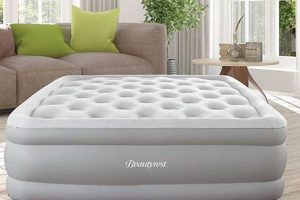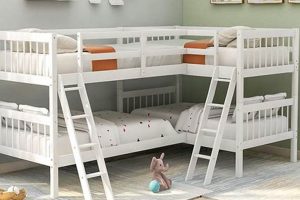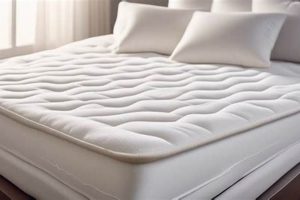Selecting a suitable sleeping surface for a trundle mechanism involves specific considerations. The defining attribute of the bed frame necessitates a thinner mattress profile compared to standard beds. This reduced thickness ensures the trundle unit can be easily stored beneath the primary bed frame when not in use. For example, a mattress exceeding eight inches in height may impede the smooth operation of the trundle function.
The right choice provides comfort and support while maximizing space efficiency. Historically, trundle beds have been employed in spaces with limited square footage, such as guest rooms or childrens bedrooms. Therefore, optimizing the available area is paramount. A carefully chosen mattress can improve the overall usability of a room, offering a practical sleeping solution without compromising comfort.
The subsequent sections will explore key characteristics to evaluate when selecting a compatible mattress, including material composition, support levels, and size considerations. Understanding these factors will facilitate informed decision-making and ensure a comfortable and functional sleeping arrangement.
Essential Considerations for Trundle Bed Mattresses
Selecting a mattress for a trundle bed requires careful attention to specific factors to ensure both comfort and functionality. The following tips provide guidance for making an informed decision.
Tip 1: Prioritize Thickness: Mattress height is a critical factor. Generally, a mattress thickness of 8 inches or less is recommended to ensure the trundle bed can be easily stored beneath the main bed frame. Measure the available space within the trundle frame before purchase.
Tip 2: Evaluate Material Composition: Foam, innerspring, and hybrid mattresses are viable options. Foam mattresses offer good contouring and pressure relief, while innerspring mattresses provide enhanced support and breathability. Hybrid models combine the benefits of both.
Tip 3: Assess Support Needs: Consider the primary user’s weight and sleeping preferences. Firmer mattresses are generally suitable for back and stomach sleepers, while softer mattresses may be preferred by side sleepers. Select a mattress that offers adequate spinal alignment.
Tip 4: Verify Dimensions: Trundle beds typically require a twin-size mattress. Ensure the mattress dimensions precisely match the interior dimensions of the trundle frame to prevent shifting or gaps.
Tip 5: Consider Weight Limitations: Check the weight capacity of the trundle bed frame. Selecting a mattress that is too heavy may compromise the structural integrity of the trundle mechanism.
Tip 6: Factor in Ventilation: Because trundle beds are often stored for extended periods, airflow can be limited. Mattresses with breathable materials, such as open-cell foam or innerspring coils, can help prevent moisture buildup and maintain freshness.
Choosing the appropriate mattress for a trundle bed involves balancing comfort, support, and space efficiency. Adhering to these guidelines will contribute to a positive sleeping experience and ensure the longevity of both the mattress and the trundle bed frame.
The subsequent section will explore specific mattress types and their suitability for use in a trundle bed configuration.
1. Thickness Limitation
Thickness limitation is a primary determinant when selecting a compatible mattress. The design of trundle beds inherently restricts vertical space, necessitating a mattress with a reduced profile to ensure proper storage beneath the main bed frame. This constraint is critical for the bed’s intended functionality.
- Trundle Frame Clearance
The available clearance within the trundle frame dictates the maximum permissible mattress thickness. Exceeding this limit will prevent the trundle unit from closing correctly, rendering the under-bed storage inaccessible. For example, if the trundle frame allows for 8 inches of vertical space, selecting a 10-inch mattress will make the trundle bed unusable as designed.
- Weight Distribution and Support
Thinner mattresses may compromise support and comfort levels compared to their thicker counterparts. Manufacturers often employ specialized materials and construction techniques to maintain adequate support within the limited thickness. An example includes using high-density foam layers to compensate for the reduced overall depth.
- Mattress Material Options
Thickness constraints can influence the range of available mattress materials. Certain materials, such as thick innerspring coils, may not be feasible within the prescribed height limit. This restriction often leads to a preference for foam or hybrid models that can be compressed to a thinner profile without sacrificing support.
- Durability and Longevity
Repeated compression and storage can impact the long-term durability of a thinner mattress. Selecting high-quality materials and construction can mitigate the effects of compression and prolong the lifespan of the mattress. For instance, a high-density memory foam mattress with reinforced edges will likely withstand compression cycles better than a low-density foam mattress.
The interplay between thickness limitation and the selection of the most suitable mattress is significant. While a thinner profile is essential for functionality, ensuring adequate support, comfort, and durability is equally important. Therefore, careful assessment of available materials, construction techniques, and individual preferences is necessary for an informed decision. Selecting the wrong mattress could lead to uncomfortable sleep and also render the trundle functionally useless.
2. Support Level
The level of support provided by a mattress directly correlates with the quality of sleep and spinal alignment, factors of particular importance in the context of a trundle bed. Due to the typically thinner profile required for trundle mattresses, achieving adequate support becomes a critical challenge. Insufficient support can lead to discomfort, back pain, and compromised sleep quality, particularly for individuals who regularly use the trundle bed. Conversely, a mattress with appropriate support ensures correct spinal alignment, promoting restful sleep and preventing potential musculoskeletal issues. The choice of materials and construction techniques significantly influences the support level; for instance, high-density foam or strategically placed coils can provide adequate support despite the reduced thickness.
Understanding the relationship between mattress thickness and support is crucial when selecting a mattress. For example, a side sleeper typically requires a softer mattress that conforms to the body’s curves, while a back or stomach sleeper often benefits from a firmer ma
ttress that prevents excessive sinking. A trundle mattress should ideally cater to the sleeping preferences of its intended user, but compromises may be necessary due to the thickness constraints. In practical terms, this means carefully evaluating the density and composition of the mattress core to ensure it delivers sufficient support for the primary user’s weight and sleeping style. The absence of proper support can negate other benefits, such as conforming or cooling properties, diminishing the mattresss value.
In summary, the support level is an indispensable element in the selection process of mattress. Balancing the thickness requirements of the trundle bed with the necessity for proper spinal alignment presents a unique challenge. Careful attention to mattress materials and construction techniques will facilitate a well-informed purchase. Prioritizing this key aspect contributes to ensuring a comfortable and restorative sleeping experience, thereby enhancing the practical utility of the trundle bed.
3. Material type
The selection of mattress material directly influences comfort, support, durability, and overall suitability for use in a trundle bed. Due to the often limited space and storage considerations associated with trundle beds, the material composition plays a critical role in optimizing performance and longevity.
- Foam Composition (Memory Foam, Polyfoam)
Foam mattresses, particularly those utilizing memory foam or high-density polyfoam, offer contouring and pressure relief. These materials conform to the body’s shape, distributing weight evenly and reducing pressure points. However, foam density affects temperature regulation and support. For instance, a low-density foam may compress excessively over time, while a high-density foam may retain heat, potentially impacting sleep comfort. In the context of trundle beds, foam mattresses are often favored for their compressibility and relatively lightweight nature, facilitating easier storage. Examples of foam mattresses include memory foam, polyfoam, latex, and hybrid foam mattresses.
- Innerspring Coils (Bonnell, Pocketed)
Innerspring mattresses utilize a network of coils to provide support and structure. Bonnell coils, an older design, offer basic support but can transfer motion easily. Pocketed coils, individually wrapped, minimize motion transfer and provide targeted support. While innerspring mattresses tend to be more breathable than foam options, their bulk and rigidity can pose challenges for trundle beds. For example, the height of the coil system may exceed the available space within the trundle frame, rendering the mattress unsuitable. Innerspring mattress includes bonnell coil, pocketed coil, and offset coil.
- Hybrid Construction (Foam and Coils)
Hybrid mattresses combine the benefits of foam and innerspring systems. Typically, they feature a coil support core topped with layers of foam for comfort and pressure relief. This construction aims to balance support, comfort, and breathability. Hybrid mattresses can be a suitable option for trundle beds, provided the overall thickness remains within the permissible limits. Hybrid mattresses includes memory foam hybrid, latex hybrid, and pocketed coil hybrid.
- Latex (Natural, Synthetic)
Latex mattresses provide a balance of support, comfort, and durability. Natural latex, derived from rubber trees, is known for its breathability and resilience. Synthetic latex offers a more affordable alternative, though it may lack some of the properties of natural latex. Latex mattresses can be suitable for trundle beds, particularly those requiring a hypoallergenic and durable option. An example, natural latex is eco-friendly, while synthetic latex might emit off-gassing odors.
Material selection is a critical determinant in identifying the most appropriate mattress. The type of material influences the mattress’s ability to meet the demands of both comfort and space considerations. For example, the selection of the wrong material (too thick) will render the trundle unusable. Hybrid or foam construction can optimize performance and user satisfaction.
4. Size Conformity
Size conformity is a non-negotiable criterion in the selection of a mattress. The dimensions of the mattress must precisely align with the internal measurements of the trundle bed frame to ensure proper functionality and prevent potential issues.
- Standard Twin Dimensions
Trundle beds are predominantly designed to accommodate a standard twin-size mattress. Deviation from these dimensions, typically 39 inches wide and 75 inches long, can lead to significant problems. For instance, an undersized mattress will shift within the frame, causing discomfort and uneven support. Conversely, an oversized mattress will not fit, rendering the trundle mechanism inoperable. A standard twin size, also helps to find bedding sheets for trundle bed.
- Thickness Considerations and Dimensional Drift
While not strictly a dimensional aspect in terms of length and width, mattress thickness is intrinsically linked to size conformity. Exceeding the maximum permissible thickness, often around 8 inches, will prevent the trundle from being fully retracted beneath the primary bed frame. Furthermore, some mattresses may exhibit slight dimensional drift over time, particularly those constructed from foam. Periodic measurement is advisable to ensure continued compatibility.
- Impact on Trundle Mechanism
Incorrect mattress sizing can exert undue stress on the trundle mechanism. An ill-fitting mattress may impede the smooth operation of the wheels or sliders, potentially causing damage or premature wear. This can necessitate costly repairs or even replacement of the entire trundle unit. Damage from improper use is typically not covered by warranty
- Safety Implications
A mattress that does not conform to the trundle frame dimensions can present safety hazards. Gaps between the mattress and the frame can create pinch points or entrapment risks, particularly for children. Ensuring a snug fit minimizes these potential dangers and promotes a safer sleeping environment.
The implications of size conformity extend beyond mere convenience. Selecting a mattress that adheres precisely to the specified dimensions is essential for functionality, durability, safety, and user satisfaction. Disregarding this critical factor can compromise the trundle bed’s intended purpose and lead to avoidable expenses and safety concerns. Therefore, verifying the dimensions prior to purchase is imperative for selecting an appropriate sleeping surface.
5. Weight Capacity
Weight capacity is a crucial, often overlooked, consideration when selecting a mattress. The structural integrity of the trundle bed frame dictates the maximum weight it can safely support, encompassing both the mattress and the occupant. Exceeding this limit can compromise the frame’s structural integrity and functionality, potentially leading to damage or failure.
- Frame Integrity and Durability
The weight capacity is det
ermined by the materials and construction techniques employed in the trundle frame’s manufacture. Exceeding this limit places undue stress on joints, supports, and moving parts, increasing the risk of bending, cracking, or complete structural failure. For example, a trundle bed designed for a 200-pound weight limit will likely suffer damage if consistently subjected to 300 pounds. This can lead to costly repairs or necessitate replacement of the entire unit. - Mattress Weight and Distribution
Mattress weight contributes directly to the overall load on the trundle frame. Denser mattresses, such as those with heavy innerspring systems or thick layers of memory foam, can significantly increase the total weight. Uneven weight distribution, caused by a mattress that sags or shifts, can exacerbate stress points on the frame. Therefore, selecting a lightweight mattress with uniform weight distribution is crucial for maximizing the trundle’s lifespan.
- Occupant Weight and Usage Patterns
The weight of the intended occupant(s) must be factored into the equation. If the trundle bed is primarily intended for children, a lower weight capacity may suffice. However, if adults will occasionally use the bed, a higher weight capacity is essential. Furthermore, usage patterns, such as frequent use or activities like sitting on the edge of the bed, can contribute to increased stress on the frame. A conservative approach, erring on the side of a higher weight capacity, is generally advisable.
- Safety Implications
Exceeding the weight capacity poses a significant safety risk. A collapsing trundle bed can cause injuries to the occupant or others nearby. Furthermore, a compromised frame may exhibit sharp edges or unstable components, increasing the risk of cuts or falls. Adhering to the manufacturer’s specified weight limit is paramount for ensuring a safe sleeping environment. Before purchase, review the trundle bed and mattress specifications for maximum weight.
Understanding and adhering to the weight capacity is integral to selecting an appropriate sleep surface. Ignoring this aspect can compromise the trundle bed’s functionality and lead to safety hazards. Thorough assessment of frame specifications, mattress weight, and anticipated usage patterns is necessary for making an informed decision, ensuring both the longevity of the unit and the safety of its occupants. A mismatch can also void the product warranty.
6. Breathability
Breathability, pertaining to airflow and moisture dissipation within a mattress, constitutes a significant factor in determining suitability for a trundle bed. The enclosed nature of trundle bed storage restricts ventilation, potentially fostering moisture accumulation and creating an environment conducive to microbial growth. Selecting a mattress with inherently breathable materials mitigates these risks, contributing to improved hygiene and prolonged mattress lifespan.
Mattresses composed of dense, non-breathable materials, such as certain types of memory foam, may trap body heat and moisture, leading to discomfort and promoting the proliferation of allergens. Conversely, mattresses incorporating open-cell foam, innerspring coils, or natural fibers facilitate air circulation, reducing the likelihood of moisture build-up and regulating temperature. For example, an innerspring mattress with a breathable ticking fabric will exhibit greater airflow compared to a solid memory foam mattress encased in a non-breathable cover. This difference is particularly relevant in humid climates or for individuals prone to night sweats. A mattress’ construction is critical to maintain the mattress hygienic state.
In summary, breathability directly impacts the comfort, hygiene, and longevity of a mattress in a trundle bed configuration. Prioritizing breathable materials and construction techniques is essential for mitigating moisture retention and fostering a healthier sleep environment. This consideration aligns with the overall goal of selecting mattress, emphasizing not only support and comfort but also the maintenance of a clean and durable sleeping surface. Selecting the correct mattress can prevent microbial growth due to air circulation factors.
Frequently Asked Questions
This section addresses common inquiries regarding the selection of a suitable mattress for trundle beds, providing clarity and guidance on key considerations.
Question 1: What is the maximum recommended thickness for a trundle bed mattress?
The recommended maximum thickness generally does not exceed 8 inches. This ensures the trundle unit can be smoothly stowed beneath the primary bed frame without obstruction.
Question 2: Are innerspring mattresses suitable for use in trundle beds?
Innerspring mattresses can be suitable, provided they adhere to the thickness limitation and the trundle bed frame’s weight capacity. Pocketed coil systems may offer superior motion isolation compared to traditional Bonnell coils.
Question 3: How does mattress material impact the breathability of a trundle bed mattress?
Mattresses constructed from breathable materials, such as open-cell foam or latex, promote air circulation and minimize moisture retention. This is especially important in the enclosed environment of a trundle bed.
Question 4: What factors should be considered when determining the appropriate support level for a trundle bed mattress?
The user’s weight, sleeping position, and personal preferences dictate the ideal support level. Firmer mattresses generally suit back and stomach sleepers, while softer mattresses may be preferred by side sleepers.
Question 5: Can an improperly sized mattress damage a trundle bed frame?
Yes. A mattress that does not conform to the frame’s dimensions can place undue stress on the trundle mechanism, potentially leading to damage or premature wear.
Question 6: How important is weight capacity when selecting a mattress for a trundle bed?
Weight capacity is a critical safety consideration. Exceeding the frame’s specified weight limit can compromise structural integrity and potentially lead to injuries.
Key takeaways include prioritizing thickness, breathability, and adherence to weight and size specifications. These factors contribute significantly to the functionality, longevity, and safety of the trundle bed system.
The following section will provide guidance on where to purchase an appropriate trundle bed mattress.
Conclusion
The selection process for the best mattress for a trundle bed necessitates a comprehensive understanding of factors that extend beyond mere comfort preferences. Thickness limitations, support requirements, material composition, dimensional conformity, weight capacity, and breathability all play crucial roles in determining the overall suitability of the sleeping surface. Each element interacts to influence functionality, durability, and safety. An informed decision requires careful consideration of these interdependent variables.
Optimal utilization of space and the guarantee of a restful sleep experience hinge upon the appropriate choice. Prioritizing the aforementioned aspects not only maximizes the lifespan of both the mattress and the trundle frame, but also ensures the continued functionality of the integrated sleeping solution. Careful evaluation and thoughtful consideration are essential steps toward a satisfactory and enduring outcome. Ignoring these crucial aspects may result in compro
mised comfort, reduced lifespan, or potential safety hazards.


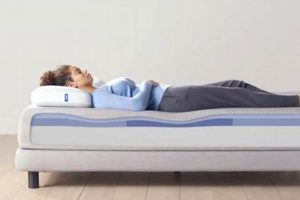
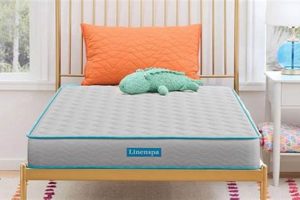
![Top Pick: What is the Best Firm Mattress? [2024] Organic & Natural Mattress Buyer’s Guide: Non-Toxic Sleep Solutions Top Pick: What is the Best Firm Mattress? [2024] | Organic & Natural Mattress Buyer’s Guide: Non-Toxic Sleep Solutions](https://mattressworldpa.com/wp-content/uploads/2025/07/th-7561-300x200.jpg)
